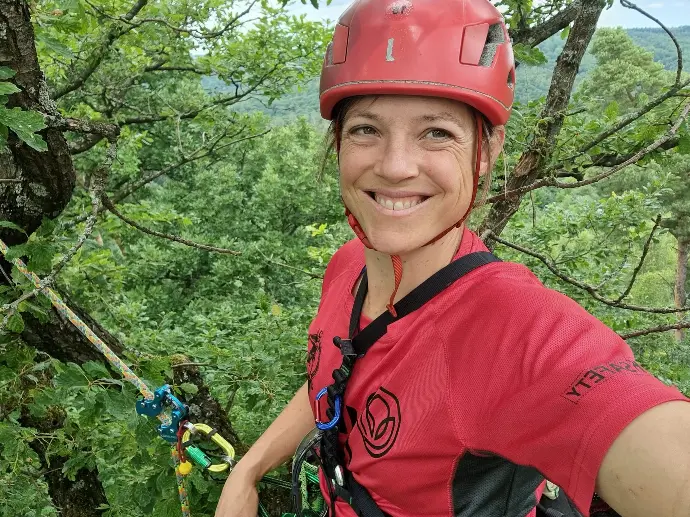Demodag "bomen beter afbreken"
Tickets
Demodag "bomen beter afbreken"
Mea culpa, mea culpa. Door onze belangstelling voor oude bomen en bodems zijn we de laatste jaren uit het oog verloren dat sommigen ook nog wel eens een boom afbreken. Uiteraard enkel met een gegronde reden.
Blijkt dat velen dat ook nog eens graag doen, want zeg nu zelf: ’t is toch mooie spielerei en een kunst om al die takken en blokken langs touwen naar beneden te laten glijden.
Daarom organiseren we speciaal voor jou een demodag afvangen en afbreken voor gevorderden met niemand minder dan onze klim- en breekkampioen Louis Luigi Reynders. Komt dat zien! Al die kunstig vliegende takken. Het wordt een spektakel van jewelste. Don’t try this at home, maar wel op een ander!
Op de koop toe krijgen we er nog een superinteressante lezing bij van Duitse superster en specialist krachtenleer in bomen Eva Mauz.
Voor wie Eva niet kent, hier leer je alles over haar:
“I’m a climbing arborist with my own tree care company, since 2014, based in Germany and an active competition climber on national, regional and international level.
Before my time in arboriculture, I studied civil and structural engineering at the University of Applied Sciences in Nuremberg, Germany and after my first degree, worked as engineer in structural design.
I continued a post-graduate master’s degree program, where I specialized on biomechanics and physics of trees and wrote my master’s thesis on tree statics and mechanical properties of green wood. After my graduation I started working as a consultant for Brudi & Partner, Tree Consult in Munich, Germany, in 2012, where I specialized on tree statics related topics, like pulling tests, windloads and structural analysis of trees. Together with Andreas Detter I developed the Software TreeCalc.
I am a brand ambassador for Teufelberger tree care equipment, where I work in product development and teach safe climbing practices and use of equipment in workshops and online tutorials. Furthermore, I hold aerial rescue trainings for tree care companies and municipalities.
With the combination of my engineering background and 12 years of experience in assessing and calculating trees and actively climbing and working in the tree care industry, I started sharing my knowledge with other arborists in recent years through workshops and lectures on climbing techniques, physics and mechanics of trees and risk assessments as well as safe climbing techniques and aerial rescue. I do my own research projects on rope alignment and tree mechanics in climbing situations, where I compare static calculations with in-situ tests, measuring forces and fiber strain in branches.”
Dit is wat Eva ons zal vertellen:
“Physical and biomechanical principles in tree climbing and rigging– How to minimize stresses on trees through rope alignment.
When working in trees, our safety is dependent on different factors. On the one hand, we have PPE and rigging equipment, where the manufacturer guarantees well defined breaking strengths. On the other hand, we have the mechanical properties of the structure on which we climb – the tree, where it generally comes up to estimating and assessing. As a third important factor we have the forces and stresses we create, and this is what we can influence the most. If we create minimal impact on the tree, the safety factor increases.
This lecture is divided into several theoretical parts. First, I show basic mechanic principles of what kind of forces and stresses we create when we work in a tree. We talk about how forces enter and move through a structure and the different types of loads that can occur. We go through the differences between compressive and bending forces and the resulting stresses.
The second step is to look at the resistance of the wood. We talk about mechanical properties and influencing factors and how to find the part in the tree where the highest stresses are likely to occur.
The third part is applying the physical theory to rigging operations. We talk about how to minimize stresses on the tree when working with heavy loads. How different rope alignments and angles influence the stresses in the structure, and how forces can be distributed and transferred through ropes. I explain the influence of friction and the impact of shock loads and dynamics.
The presentation will include interactive exercises so that the audience can apply certain lessons and see key points. Room will be left for discussions and questions. We can go through scenarios and experiences from your working life and analyze them in regards to physical principles.”
